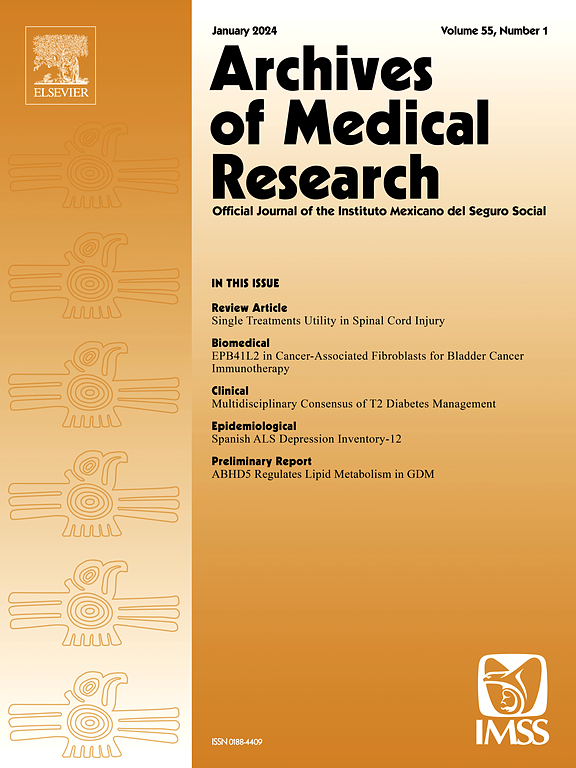Projections of the Burden of Rheumatoid Arthritis in Mexico from 2020 to 2040
IF 3.4
3区 医学
Q1 MEDICINE, RESEARCH & EXPERIMENTAL
引用次数: 0
Abstract
Background and Aims
Rheumatoid arthritis (RA) can lead to disability and premature death. Knowledge of the RA burden is necessary for strategic healthcare management, resource allocation, and preventive measures. The burden of RA was analyzed with projected rates for 2030 and 2040.
Methods
Incidence, prevalence, mortality, and burden of suffering from RA were analyzed using the most recent Global Burden of Disease (GBD) dataset for RA from 1990 to 2019. Predictive estimates were calculated using the SPSS Time Series Modeler.
Results
In 2019, approximately 530,000 individuals had RA (64.0 % were female, and 35.9 % were between 15 and 49 years old). The age-standardized prevalence (ASP) and incidence (ASI) rates were 427.6 and 25.4 cases per 100,000 people, respectively. The Mexican states with the highest ASP, disability-adjusted life years (DALY), and years of healthy life lost due to disability rates were Oaxaca, Tlaxcala, and Zacatecas. The national ASP and ASI rates of RA are projected to increase to 465.5 and 27.9 by 2030, and to 518.9 and 30.2 per 100,000 inhabitants by 2040, respectively. In contrast, age-standardized mortality and DALY rates are projected to decline to 1.2 and 77.8 in 2030 and 1.1 and 73.6 per 100,000 inhabitants in 2040, respectively.
Conclusions
The burden of RA, especially the burden of disability continues to increase. Despite substantial investments in clinical care, research, and public health initiatives, the rate of increase shows no signs of abating. Certain regions of Mexico, such as Oaxaca, Tlaxcala, and Zacatecas, have a disproportionately high burden.
2020年至2040年墨西哥类风湿关节炎负担预测
背景与目的类风湿性关节炎(RA)可导致残疾和过早死亡。了解RA负担对于战略性医疗保健管理、资源分配和预防措施是必要的。对RA的负担进行了分析,并预测了2030年和2040年的发病率。方法使用最新的全球疾病负担(GBD)数据集分析1990年至2019年RA的发病率、患病率、死亡率和患者负担。使用SPSS Time Series Modeler计算预测估计。结果2019年,约53万人患有RA,其中女性占64.0%,年龄在15 - 49岁之间的占35.9%。年龄标准化患病率(ASP)和发病率(ASI)分别为每10万人427.6例和25.4例。ASP、残疾调整生命年(DALY)和因残疾率而损失的健康生命年数最高的墨西哥州是瓦哈卡州、特拉斯卡拉州和萨卡特卡斯州。到2030年,全国平均年龄和平均年龄的RA比率预计将分别增加到465.5和27.9,到2040年将分别增加到每10万居民518.9和30.2。相比之下,预计到2030年,年龄标准化死亡率和DALY死亡率将分别降至每10万居民1.2人和77.8人,2040年降至每10万居民1.1人和73.6人。结论RA负担,尤其是致残负担持续加重。尽管在临床护理、研究和公共卫生倡议方面进行了大量投资,但增长率没有显示出减弱的迹象。墨西哥的某些地区,如瓦哈卡州、特拉斯卡拉州和萨卡特卡斯州,有不成比例的高负担。
本文章由计算机程序翻译,如有差异,请以英文原文为准。
求助全文
约1分钟内获得全文
求助全文
来源期刊

Archives of Medical Research
医学-医学:研究与实验
CiteScore
12.50
自引率
0.00%
发文量
84
审稿时长
28 days
期刊介绍:
Archives of Medical Research serves as a platform for publishing original peer-reviewed medical research, aiming to bridge gaps created by medical specialization. The journal covers three main categories - biomedical, clinical, and epidemiological contributions, along with review articles and preliminary communications. With an international scope, it presents the study of diseases from diverse perspectives, offering the medical community original investigations ranging from molecular biology to clinical epidemiology in a single publication.
 求助内容:
求助内容: 应助结果提醒方式:
应助结果提醒方式:


